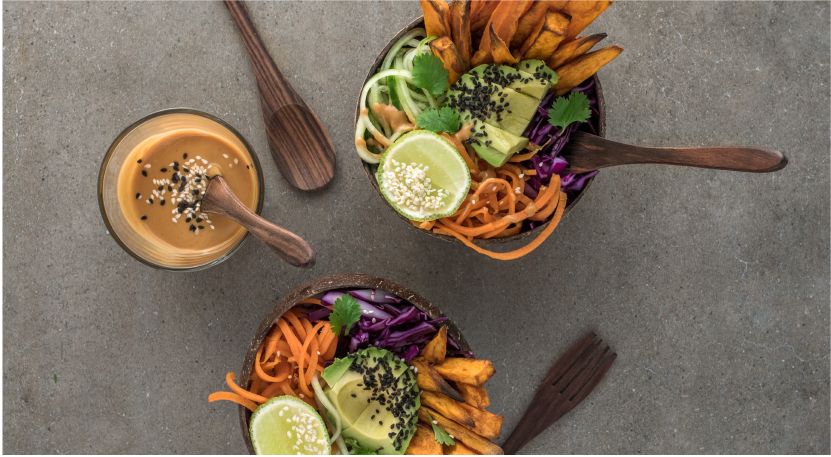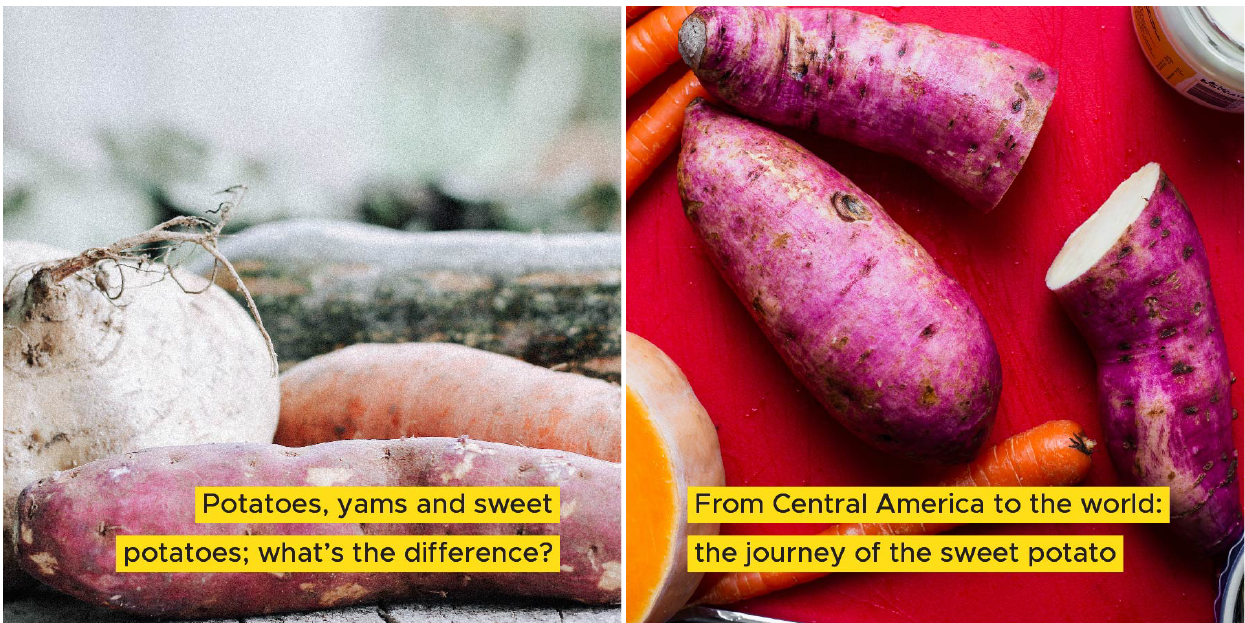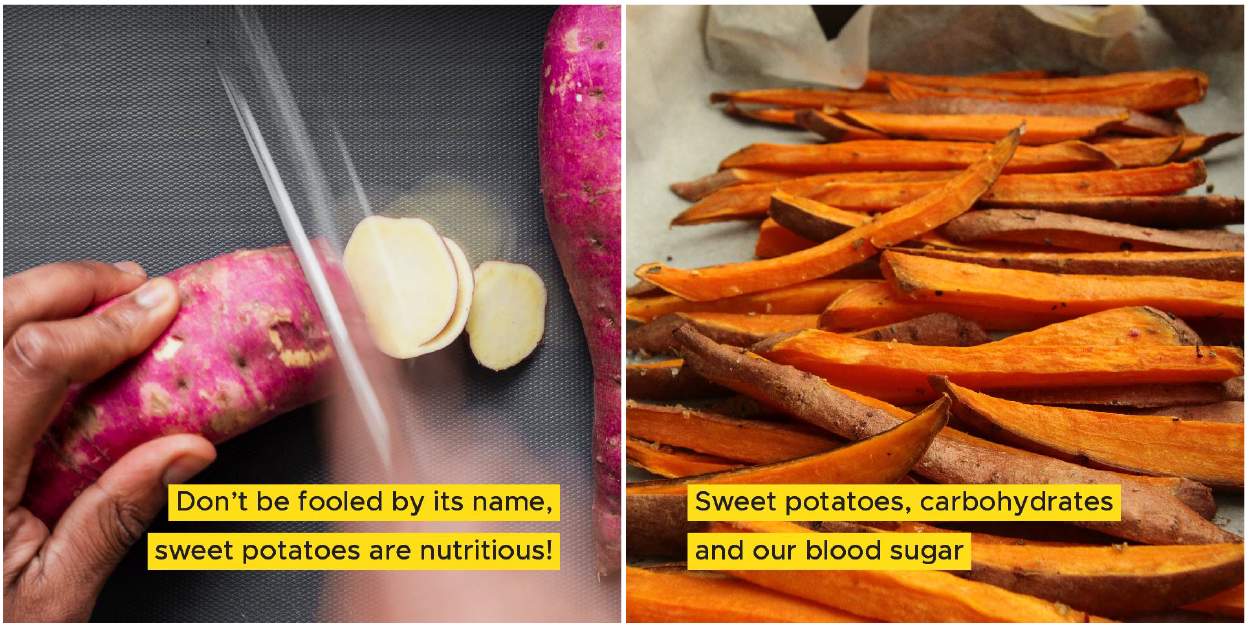Food Feature: Sweet Potatoes
Published: 06-Jul-2021 Category: Food Bulletin Newsletter

By Ashok Vasudevan
Food Feature: Sweet Potatoes
Contrary to what their name might suggest, sweet potatoes are actually an edible root in the morning glory family, and unrelated to true potato tubers.Immediately recognisable by their vibrant orange flesh, sweet potatoes come in a dazzling array of colors from white to cream to purple! True to their name, sweet potatoes have a naturally sweet taste which is enhanced through cooking methods like roasting. In addition to the fleshy root, the leaves are also edible and commonly eaten in some countries.
Today we learn more about the sweet potato, its health benefits and some tips around cooking it.

Potatoes, yams and sweet potatoes; what’s the difference?
When we think of tubers like potatoes, sweet potatoes, yam, cassava, Taro etc. their similarity to grains hardly strikes us, yet tubers and grains are the main source of inexpensive energy in the plant kingdom. At the core of it, they come from botanically different plant families, but they pack serious nutrition. Brown tubers contain decent amounts of Vitamin C and the white & yellow varieties have beta carotene. Sweet Potatoes are nutritionally dense - rich in Vitamin A, (100% DV) Vit C and B6, but in calories and carbs they are similar to potatoes. But these are all good sources of dietary fiber. The wisdom lies in not combining tubers with starch-heavy foods like cereals (rice, wheat, corn etc.), but to enjoy them separately. While corn and potatoes, potato burgers and even aloo parathas are delicious, those double carbs and calories will add up quickly. Moderation may be the key word.
From Central America to the world: the journey of the sweet potato
Sweet potatoes are believed to have originated between Polynesia and Central America, with relics dating back more than 10,000 years that were discovered in Peruvian caves. The Polynesian word for sweet potato - “Kuumala” - closely resembles the word “Kumara” used by Andean natives. Christopher Columbus was thought to have brought sweet potatoes to Europe after his voyage to the New World in the 15th century. By the 16th century, records indicate that Spanish explorers had brought this onto Africa, India, Indonesia and South Asia where it remains a staple food in many cuisines.

When we think of tubers like potatoes, sweet potatoes, yam, cassava, Taro etc. their similarity to grains hardly strikes us, yet tubers and grains are the main source of inexpensive energy in the plant kingdom. At the core of it, they come from botanically different plant families, but they pack serious nutrition. Brown tubers contain decent amounts of Vitamin C and the white & yellow varieties have beta carotene. Sweet Potatoes are nutritionally dense - rich in Vitamin A, (100% DV) Vit C and B6, but in calories and carbs they are similar to potatoes. But these are all good sources of dietary fiber. The wisdom lies in not combining tubers with starch-heavy foods like cereals (rice, wheat, corn etc.), but to enjoy them separately. While corn and potatoes, potato burgers and even aloo parathas are delicious, those double carbs and calories will add up quickly. Moderation may be the key word.
From Central America to the world: the journey of the sweet potato
Sweet potatoes are believed to have originated between Polynesia and Central America, with relics dating back more than 10,000 years that were discovered in Peruvian caves. The Polynesian word for sweet potato - “Kuumala” - closely resembles the word “Kumara” used by Andean natives. Christopher Columbus was thought to have brought sweet potatoes to Europe after his voyage to the New World in the 15th century. By the 16th century, records indicate that Spanish explorers had brought this onto Africa, India, Indonesia and South Asia where it remains a staple food in many cuisines.

Don’t be fooled by its name, sweet potatoes are nutritious!
The bright orange hues of the sweet potato flesh can be attributed to its high levels of beta-carotene. In fact, sweet potatoes contain one of the highest levels of beta-carotene amongst plant-based foods. Couple that with the fact that it is readily available all year round, and you have a standout antioxidant food! To enjoy the full beta carotene benefits, research suggests pairing it with just 1 tbsp of fat to improve the absorption of the fat-soluble beta carotenes. Also rich in fibers and a range of minerals like iron, calcium and B Vitamins and Vitamin C.
Sweet potatoes, carbohydrates and our blood sugar
Starchy root vegetables are usually counterproductive when managing blood sugar levels, as the starch can be converted into simple sugars. Although sweet potatoes have a medium glycemic index rating, it also contains high amounts of fiber and the resulting impact on blood sugar spikes is surprisingly minimal. Initial studies also show that sweet potatoes increase the amount of adiponectin proteins, which in turn are important insulin metabolism modifiers. A quick tip on cooking; the average GI for roasted sweet potatoes is 82, for baked sweet potatoes is 94, but boiled sweet potatoes is 46. Try boiling if you are concerned about blood sugar impact.
The bright orange hues of the sweet potato flesh can be attributed to its high levels of beta-carotene. In fact, sweet potatoes contain one of the highest levels of beta-carotene amongst plant-based foods. Couple that with the fact that it is readily available all year round, and you have a standout antioxidant food! To enjoy the full beta carotene benefits, research suggests pairing it with just 1 tbsp of fat to improve the absorption of the fat-soluble beta carotenes. Also rich in fibers and a range of minerals like iron, calcium and B Vitamins and Vitamin C.
Sweet potatoes, carbohydrates and our blood sugar
Starchy root vegetables are usually counterproductive when managing blood sugar levels, as the starch can be converted into simple sugars. Although sweet potatoes have a medium glycemic index rating, it also contains high amounts of fiber and the resulting impact on blood sugar spikes is surprisingly minimal. Initial studies also show that sweet potatoes increase the amount of adiponectin proteins, which in turn are important insulin metabolism modifiers. A quick tip on cooking; the average GI for roasted sweet potatoes is 82, for baked sweet potatoes is 94, but boiled sweet potatoes is 46. Try boiling if you are concerned about blood sugar impact.

